In its convoluted history, Asheville’s River Arts District has survived fire and flood, not to mention neglect. Now it will have to survive its own growing popularity.
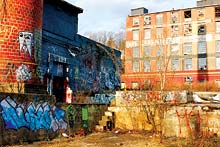
You may have heard of the area. Good Morning America and The New York Times have both recently spotlighted our local artists’ enclave, and 20/20 is preparing its own feature.
It wasn’t always thus. For much of the last half-century, the area sat largely abandoned, except for a few die-hard businesses. Before that, the district’s fortunes had varied widely. In the late 1800s, it served as Western North Carolina’s industrial hub, thanks to its river access and railroad depot. It was also a recreational destination, though in the wake of the great flood of 1916, the area became strictly industrial. After the Great Depression, it gradually sank into neglect.
But beginning in the 1980s, enterprising artists started moving in, taking the first steps toward establishing today’s thriving arts district. Around the same time, RiverLink began a long-term campaign to revitalize the area, creating a master plan and launching an ambitious program of park and greenway development as well as working with property and business owners and area residents (see sidebar, “A Long Campaign”).
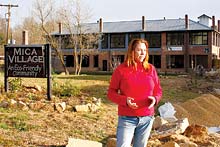
During the next decade or so, more people set up shop there, creating a growing artists’ community. As with downtown’s revival, however, progress was slow. And for a while, to the casual observer driving by, there was little sign of change amid the jumble of old warehouses.
Now, however, those gradual efforts are reaching critical mass. With rampant downtown development and prices climbing ever higher, the River District is getting attention not only from the media, but also from people trying to make a difference—or a buck.
“The people who come down here aren’t afraid of challenges. They aren’t afraid to be pioneers,” says Cindy Weeks, project director for Mountain Housing Opportunities. The nonprofit has had its eyes on the river for several years, culminating in the planned renovation of the former Glen Rock Hotel on Depot Street and construction of a new affordable-housing project there. “The attraction,” she says, “is that it is a little grittier.”
And indeed, grit is what you get. The district is fraught with challenges to development, including the new flood maps released by the state. As recently as 2004, the ground floor of many buildings in the district was underwater, and the memory lingers. In addition, many properties contain hazardous wastes left over from the area’s industrial heyday, requiring analysis and cleanup under the EPA’s Brownfields Program.
“Downtown was the low-hanging fruit compared to the river,” says Jolene Mechanic, who opened galleries in 2002 in the Phil Mechanic Building on Roberts Street. But with downtown rapidly filling up, she notes, undeveloped space anywhere near the central business district starts looking good. “This is the last frontier.”
In the spotlight
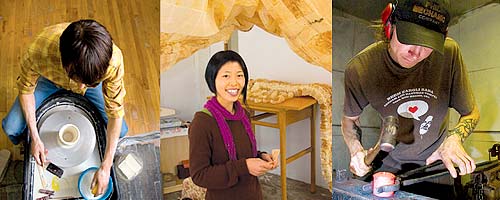
Neighborhood residents are protective of that frontier. Strictly speaking, the River Arts District is a tightly knit cluster of buildings surrounded by Roberts, Lyman and Depot streets and Clingman Avenue. Within those somewhat fluid boundaries, brick and steel are the rule. Skeletons of former activity are still visible—from old industrial property to junk cars and even past and current art projects. The periodic cacophony of trains coming and going is a reminder that the area remains a major railroad hub for Western North Carolina.
Perched across the railroad tracks, the Glen Rock Hotel is not within the River Arts District. But it does fall within the more loosely defined River District, which seems to include anything in the river corridor that’s not too far from Asheville. And along with other nearby developments, it will have an undeniable impact on the arts enclave, as developers tout their projects’ proximity to it and more artists and nonartists take up residence there.
Meanwhile the semiannual Studio Strolls sponsored by the River District Artists and regular open houses and other events are drawing ever-bigger crowds, and the arrival of dining options within the last few years has meant that people stay longer. When the Clingman Café opened, sales at the Studio Strolls nearly doubled, says Curve Studios owner Pattiy Torno, “because people didn’t have to leave to go get lunch.”
12 Bones Smokehouse, which opened within the last couple of years, recently won Good Morning America‘s Best Bites contest, and a brewery is slated to open on the ground floor rear of the Wedge Galleries within the next month.
“I think the potential for growth here is unlimited,” says Clingman Café owner Trip Howell. “And I mean good growth. Growth has to be done in the right way.”
So far, at least, there doesn’t seem to be much fear in the arts community of getting displaced by giant development projects. “We don’t really see huge developers coming here and doing huge things,” says Weeks. Other artists interviewed seemed to echo that sentiment.
Still, Torno, a longtime neighborhood denizen who serves on the city’s River District Design Review Committee, said she took on that role because of concerns about developers moving into the river corridor. “We were seeing some crappy projects,” she says.
At this point, most buildings within the district are owned by artists or people who support the arts community—another reason many artists aren’t worried. But that doesn’t mean the area is immune to rising interest.
A long campaign
by Brian Postelle
“You didn’t see a lot of people walking around the streets here,” recalls Karen Cragnolin, talking about what’s now become a focal point for arts activity in Asheville. “It was isolated. It was a nondestination.”
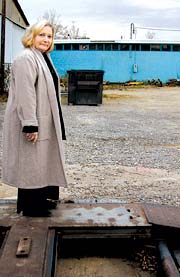
Cragnolin, executive director of RiverLink, ran the group out of her home before moving into the Warehouse Studios on Lyman Street in 1989. Opening up the top floor for artists’ studios made the property the first of the district’s old industrial buildings to be converted to office and studio space.
At the time, she says, studio strolls supported by a handful of artists would attract a modest number of people lured by the prospect of free drinks. But the idea was always to draw attention to the waterways.
“The really earth-changing thing was, we were doing a lot of canoe trips on the river,” Cragnolin explains. “We were taking everybody out all the time.”
“People said, ‘It would be great if we could get down to the river, use the river, live next to the river,” she notes. Then and now, RiverLink’s mission is to facilitate that goal by reclaiming surrounding property and buildings, creating parks and greenways, and championing water quality.
To that end, the nonprofit created French Broad River Park in 1992 and developed what Cragnolin calls the first greenway in Asheville. “People said, ‘What’s a greenway?” she recalls. “And we said, ‘Well, let’s show them.”
Since then, the group has continued to acquire property and convert it into parkland—all with private funding—and donate the finished products to the city. Carrier Park on Amboy Road followed in 1999.
In the process, RiverLink has established important relationships with funding organizations like the locally based Janirve Foundation, which helped fund property acquisitions. Another lasting relationship has been built with Progress Energy (formerly CP&L), whose most recent fruits involve property on the east side of the French Broad River.
In 2004, RiverLink crafted the ambitious Wilma Dykeman RiverWay Plan. Since adopted by the city of Asheville and other local governments, it will eventually establish a 17-mile network of greenways, parks and walking paths along the French Broad and Swannanoa rivers.
“It won’t be [encroachment by developers]. It will be property taxes,” Torno warns. As property values rise, even artists who bought their lofts years ago when prices were much lower may feel pressure to sell, she notes.
Banking on the banks
A major player in the district’s new development is Urvana LLC, headed up by Whit Rylee and Jon Sheintal. Their company is spearheading the reclamation of the adjacent Chicken Hill neighborhhood, restoring historic homes there and creating a mixed-use development on the site of the former Chesterfield Mill.
“They are companion projects in a sense,” says Rylee. Ten years ago, the partners began buying property in the area, which originally housed mill workers. This year, the Chesterfield Mill site became available, and though Rylee says he had to strectch financially to make the purchase, “You don’t get that opportunity again.” Urvana voluntarily held public charrettes to see what the community would most like to see on the site.
For MHO, says Weeks, the River District is a place where it’s still possible to develop affordable housing. In the works for a number of years, the Glen Rock project will include the restoration of the old hotel as office space and the construction of a new, 80,000-square-foot, mixed-use building.
The key to the ambitious plan was a new city zoning category, the “urban place district,” which is meant to encourage higher-density development. It was created in 2005, and the Glen Rock project was the first to receive the designation. The Chesterfield Mill was later assigned the same designation. “The city approached us,” notes Rylee. “That’s unheard of.”
In Weeks’ view, this is a sign that the city is turning its attention to the area and recognizing its potential. “How often does a city plan and the market agree?” she asks. “I thought it was a really beautiful moment when that happened.”
Recognizing the arts district’s growing momentum, the Fine Arts League of the Carolinas—a nonprofit school that emphasizes classical techniques in drawing, painting and sculpture—has moved into a building on the Glen Rock property.
Meanwhile RiverLink, a key player in the district for nearly two decades, is following up its continuing work along Amboy Road with a push to extend the greenway along Riverside Drive. To this end, the nonprofit is working with Progress Energy on its property behind 12 Bones and has acquired the former B&H Sheet Metal property. Eventually, the planned network of parks and green spaces will connect connect West Asheville, downtown and Biltmore Village via the River District.
Speaking about her group’s park-development projects, Executive Director Karen Cragnolin says, “We just want to make sure it is going to be public space forever.” Already, she notes, French Broad River Park, Carrier Park and the connecting greenway—all developed by RiverLink—have prompted developers to step forward with mixed-use plans along Amboy Road. “We see the same thing happening [in the River Arts District].”
Up and down the river corridor, in fact, developers are billing the district as a selling point for their condominium projects, even if they’re several miles away.
“Everything is moving in this direction,” says Tony Cecil, who’s preparing to build The River condo project on Riverside Drive, about two miles from the arts district proper. Touting the proximity to both downtown and the arts district, Cecil says 40 percent of the units have already been reserved. At the same time, he notes, the site is safely out of the floodplain.
“This area is a little more favorable,” says Cecil, noting that only one train track runs by the property. But the site’s industrial nature, he maintains, is part of the allure. In some other cities, you’d be laughed out of the room for trying to market something like this, says Cecil, but “Asheville people are more open-minded.”
Several miles to the southeast of the district stands another new condo development, the Lofts at Mica Village, on Thompson Street. Built along the Swannanoa River at the edge of Biltmore Village, the condos clearly aren’t in the River Arts District. But they are in the greater river corridor, and the challenges of building there are similar to those encountered in the French Broad’s industrial zone.
Built in an old mica factory, the condos sit within the floodplain, and the property went through the EPA’s Brownfields Program. But to developer Regina Trantham, the site seemed perfect—warts and all.
“People are talking about growing up or growing out. Maybe there’s a third answer in what has been left and abandoned,” she says, noting that at least 10 developers she knows are looking to the river for new land.
“The river corridor is providing the work and living space that downtown did 20 years ago,” says Trantham. “Downtown has priced out the middle class.”
To address the risk of floods, the building’s ground floor is reserved for parking, and the electrical system was installed above the flood line. In addition, the property has been landscaped to reduce storm-water runoff into the Swannanoa.
“I think the river has been ignored and abused for a long time. You are talking about areas that were literally a dump,” she says. “People are starting to recognize the importance of working with the river.”
To reduce construction waste while reflecting the River District’s history, Trantham’s development reused various materials reclaimed from the old factory building, including glass and wood. She also says she hopes the project will help alter long-standing prejudices against the riverfront. “I would feel more comfortable living on a brownfield than anywhere else,” she observes, “because it’s certified.”
And banks that have been hesitant to finance such developments may change their tune when they see the eager response from buyers, says Trantham. “The more we talk about it, the easier it will get.”
Go with the flow
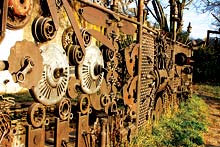
From the city’s standpoint, though, the biggest news concerning the corridor is the release of new flood maps, which will play a large part in determining storm-water regulations and riverside buffers. Once the new data has been digested, it will greatly impact both the type and amount of development that can happen near the water’s edge. The city is hosting a series of meetings to solicit public input on the maps.
“I think we’ll see more movement in 2008, but there’s just a lot to work on,” says Urban Planner Alan Glines.
Meanwhile, yet another concern is taking shape in the neighborhood: a proposed traffic circle at the junction of Haywood Road and Roberts Street. A gateway into the River Arts District, the intersection is also a hazard for pedestrians in the district, who must cross five lanes to get from one part of the district to the other. Artists say that cars heading downtown from West Asheville pose a hazard to cars and pedestrians alike. Riverfront businesses, however, want to make sure that any retooling of the intersection will still accommodate their trucks.
Several city departments, including Engineering, Parks and Recreation, and Planning and Zoning, are collaborating on developing strategies for dealing with the area’s growth, says Glines. “The River District will get a lot of attention,” he predicts. “It has been slow getting off the ground, but there is movement in the right direction.”
Meanwhile, working artists in the district are trying to adjust to the increased visitation while preserving the rivets, brick and rust that have defined their neck of the woods. Thanks to the growing popularity of the public events, some artists now sell on-site what they used to market—at a lower profit margin—via other people’s galleries.
“There’s a lot of discussion whether this is production space or retail space—or is it both?” notes Torno. “In the last five years, the shift has been to both.”
Blacksmith Alwin Wagener, for one, is now working on building a gallery space in his studio to display his creations. “A lot more people are going in that direction,” he says. Looking out over the railroad tracks behind the Wedge Building, he emphasizes that artists belong in the rough-hewn district, and that art is consistent with the area’s history.
“This is our industry,” Wagener proclaims.
Weeks agrees, observing, “What we don’t want to do is throw away the legacy of industry down there.”



Old Asheville Glass is a building in the river district. Over the last few years several friends and artistic partners of mine have lived and worked there. We had a band practice space and even a show space for bands both local and touring. TONS of great art and music used to happen there, until one day when the fire marshal showed up on an anonymous phone call, and evicted everyone inside. When my friends replied with “we’ve been paying rent here legitimately the whole time” the fire marshal said that the landlord denied knowing anything about people living in the building, even though he had been taking rent from my friends for several years. Along with Old Asheville Glass, the long running bike recyclery has now been evicted, and forced to relocate. We suspect the anonymous tip came from a person in a nearby studio, who for whatever reason, just didn’t want us there. At no point was anyone inside in any danger and we had never received a complaint from anyone in the area for noise or anything else. It is obvious that the gentrification of downtown is now spreading into the arts district. Soon it will be nothing but “safe” “nice” “pretty” art for rich tourists to stroll through. This is not an attack on any of the artists working in the district, it is a call to them, because soon or later the same thing could happen to you.
“Soon it will be nothing but “safe” “nice” “pretty” art for rich tourists to stroll through”…..quote from former comment.
This is true. Being a former ‘River District’ artist I saw the need for affordable rental space, not new, high priced space. It seems that the landlords of many River District buildings are in the business to make a buck instead of providing studio space for ‘regular’ people. The Candle Station is one space where this is happening. Forced to find studios elsewhere, artists are bumped out for ‘new and older’ artists that can afford their modern, smaller spaces. In my opinion, they are catering to retirees who’d like to start a new hobby and money from elsewhere. When the local artists are forced to move out of town towards cheaper rent…they’ll realize what a mistake they’ve made. Asheville will no longer be a ‘trendy’ artist haven, it will be pre-fabricated city of generic art and plastic people.
“When a place gets boring, even the rich people will leave.” An important question for Asheville to consider: “Where is the place for new, young things?” Every city needs to have those sections of town where young entrepreneurs can get started. The development cycle for this city is so dramatically quicker than other larger cities. From an economic standpoint, this city needs to be aware of the not so longterm implications of catering only to the rich people, and of ignoring the home grown talent already here. Homogeneity will follow. Do we really want to look like Anywhere USA?
If the city is turning into a prefab city of generic art and plastic people, exactly what are you doing to fight back? At this point, the invasion is in full swing, and all those of us who want Asheville to get its edge back can do is fight it, instead of rolling over and letting developers and their rich dolt Buckhead clients run you out of neighborhood after neighborhood.
This is YOUR city, not Biff and Muffy’s. It was yours before they saw it, swooned at the oozing “quaintness” of it all, and decided they simply had to have some of it, plus tell all their friends back home over a game on the links. Play your cards right, and it will be your city after they lose interest and wander off to the next McMansion development somewhere else.
Problem is, no one’s fighting back. We’re losing downtown, although even there, there’s still a chance, and nobody wants to see any other neighborhoods sterilized and given over to the dolts.
So, what are you doing to fight back?
Great article.
I live just across the river from The District, and all of this information is germane. I’d like to see a small grocery down there as well as some rent control for the artists.